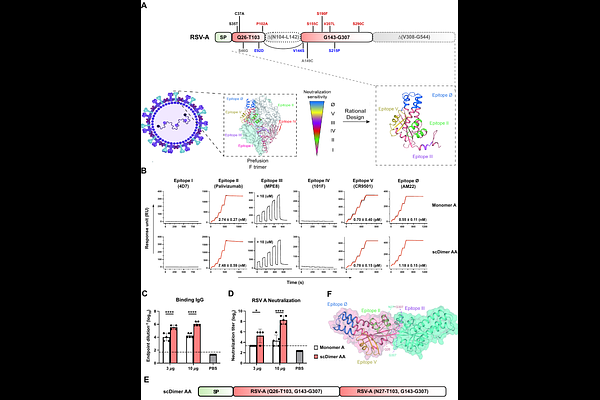Rational design of respiratory syncytial virus dimeric F-subunit vaccines in protein and mRNA forms

Rational design of respiratory syncytial virus dimeric F-subunit vaccines in protein and mRNA forms
Li, J.; Ma, X.; Xu, Z.; Guo, W.; Peng, R.; zhang, Y.; Meng, Y.; Wang, Q.; Li, S.; Chen, J.; Guo, Y.; Lu, X.; Wang, Q.; Guo, Y.; Jia, M.-a.; Li, Y.; Zhang, Y.; Li, S.; Du, P.; Wang, Q.; Gao, G. F.; Qi, J.
AbstractBackground: Respiratory syncytial virus (RSV) poses a significant public health threat, particularly to children and the elderly. Two protein-based vaccines and one mRNA vaccine have been approved, all targeting the prefusion conformation of the fusion (F) glycoprotein. However, it has been reported that the F protein transitions to the post-fusion state during storage, resulting in a reduction of the vaccines\' immunogenicity. Methods: In this study, we engineered novel pre-F-based antigens to preserve pre-F-specific immunodominant epitopes while eliminating sub-potent ones. Based on this, we constructed a series of single-chain dimers and selected the one with the highest expression yield and melting temperature (Tm). Next, we created a heterodimer, scDimer AB. Structural and protein characterization analyses were conducted to verify our design. All monomeric and scDimer antigens were used to immunize rodent models. Additionally, we prepared the antigens in mRNA form and immunized BALB/c mice. Finally, we combined both antigen forms, administering intramuscular mRNA priming followed by intranasal protein delivery in mice. In all immunization strategies, viral challenges were performed in animals to evaluate the immunologic protective effects. Findings: Through rational design, we developed a monomeric and two single-chain dimeric (scDimer) proteins with the expected characteristics, including complete II, V, and 0; epitopes and a partial III epitope. The scDimers elicited stronger binding and neutralizing antibody responses in rodent models compared to the monomer, and they also boosted T cell responses when combined with appropriate adjuvants. After three doses of scDimer immunization, live RSV was barely detectable in the tissues of infected animals. The copies of RNA encoding N-gene were significantly reduced in the immunized groups compared to the PBS-injected control groups. We also engineered mRNA versions of the antigens and verified their protective efficacy in mice. Notably, there were no significant differences between intranasal boost and intramuscular two doses after RSV challenged, suggesting that intranasal boost provided equivalent protection to intramuscular vaccination and could reduce the risk of vaccine-enhanced disease (VED) potentially. Interpretation: The scDimer-based RSV vaccines effectively protected rodents from RSV infections, highlighting their clinical potential. Our antigen design removed certain suboptimal epitope regions, enhancing the efficiency of antigen presentation and increasing the proportion of the most potent pre-F-specific neutralizing antibodies. This approach provides a novel perspective for future vaccine design.